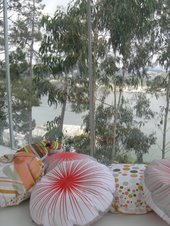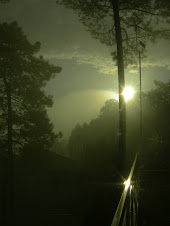From an interview with Starhawk:
“Permaculture began as a way to imitate the relationships found in nature in order to design human communities and agricultural systems. As Star tells us in this interview, two Australians — Bill Mollison and David Holmgren — discovered many of the principles of permaculture while studying the Tasmanian rainforest. Their interest began when they started to ask questions like “Why is the rainforest thriving when no one is pruning it, spraying it for bugs, or fertilizing the soil? How does it care for itself? And why couldn’t we grow food for humans in the same way that the rainforest provides for itself?”
According to Star, Bill and David developed a set of ethics and principles based on what they discovered about natural systems. The ethics are quite straightforward: 1) Care for the Earth, 2) Care for people, and 3) Care for the future a) by sharing the surplus, b) by returning what you have to the land, and c) by limiting your consumption. These ethics guide the way permaculture implements its principles and creates and designs its systems.
According to Starhawk, permaculture’s many principles derive from one overarching understanding, namely that we should look at systems and relationships rather than at separate, isolated objects. This is also the core of Pagan philosophy and indigenous spirituality. For example, the Lakota say “Ho mitakuye oyasin,” meaning “all our relations,” a saying that indicates many times a day that we are a part of an interconnected whole. Within the Goddess movement, we also view life as a set of relationships. It’s our relationship with the natural world that sustains our lives, and it’s the relationships within nature that sustain the biodiversity, abundance, and beauty in our world.
Permaculture’s principles can be easily deduced, according to Starhawk, if you ask a few basic questions: For example, where are things in relationship to each other? If systems are designed to create the right relationships, Star told me, it saves a lot of energy, a lot of material, and a lot of human effort. So, for instance, if you catch water high enough up in your landscape, you won’t need to pump it. Or if you place your garden near your house, you will be able to tend it as you walk through it during the course of your day. And if you place those plants that need the most tending closest to your house, you’ll notice their needs and take care of them in a timely maner. One of the sayings of the permaculture movement is that if your woodpile is between the house and the outhouse, you’ll be able to bring in a few sticks at a time and never have to burden yourself with the heavy task of fetching wood.
Another good question from the perspective of permaculture is when things happen in relation to each other. Using the example of a garden again, you need to prepare the ground first, before you plant any seeds. Then the seeds can take root and thrive. This principle doesn’t just apply to gardens, Star told me, but is a sound economic standard as well. We need businesses to become rooted in our communities and become responsible to them. We desperately need these moral values at this time in history as a counter to climate change and to the oppressive aspects of globalization. Local institutions will not deplete our energy resources as quickly as those located far away. And instead of extracting wealth for shareholders who live someplace else, our businesses will be accountable and serve the needs of their own communities and provide a decent livelihood for the people work for them.
Another permaculture principle Starhawk talked about is catching and storing energy. The sun showers us everyday with energy, and if we can catch it, store it, and reuse it, that provides us with abundance. We can capture sunlight with solar panels, but we can also absorb it in the plants we grow and eat. This principle can also be translated into an economic concept. It’s easy to see that it’s not the number of dollars that come into a community that generates wealth, but how often they recirculate before they leave the area.
In nature, there’s no waste, Starhawk went on to say. When one thing dies, it feeds another. In fact, even one creature’s excretions can become another creature’s resource. Permaculture has developed a corollary to this natural principle, namely that pollution is an unused resource. Star’s example highlighted this concept. Sewage can be a tremendous pollutant, she said, but when dealt with properly, it can become a great source of nutrients. Millions of children die every year from water contaminated by sewage, but in reality, it’s not hard to deal with human waste. It’s only dangerous when it’s flushed away in water that then can’t be used for other purposes. Star tells her students that there’s nothing easier than building a composting toilet that can turn that lethal substance into a natural fertilizer that can then help grow crops or trees. What’s so interesting is that when we start to learn these things, we realize that there’s a cycle of destruction that we can turn around, creating a cycle of regeneration and rebuilding instead. “The problem is the solution,” Star said, quoting another permaculture saying.”



.jpg)
.jpg)











Sem comentários:
Enviar um comentário